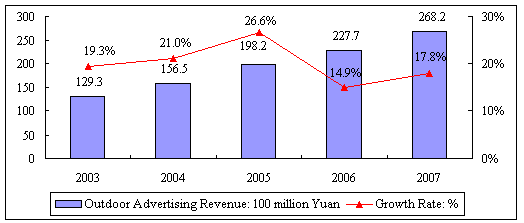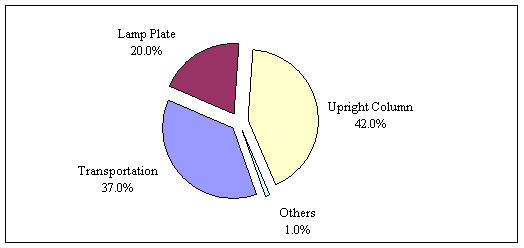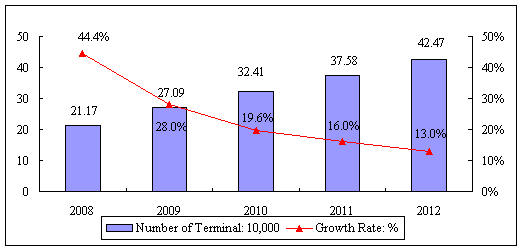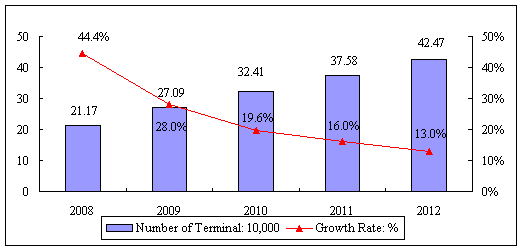CCID Consulting: China's Onboard Mobile TV Market Enters Fast Growth Period
Wednesday, March 26th, 2008BEIJING — CCID Consulting (Stock code: HK8235), an authoritative ICT research and management consulting firm and leading IT outsourcing service provider in China, and the first Chinese consulting firm listed in Hong Kong (Hong Kong Stock Exchange: HK08235), released on March 4, 2008, the 2007-2008 Annual Report on China’s Onboard Mobile TV Market at the Consumer Electronics Market China 2008. The report shows that the year 2007 was an extremely important year for China’s onboard mobile TV market. A series of events in the areas of policy environment, development of standards and market applications all produced a profound influence in the future development of onboard mobile TV in China.
Through several years of development, onboard mobile TV has seen the establishment of a relatively effective operation system for cooperation in the industry chain, laying the foundation for further development. Meanwhile, the terrestrial transmission standards for onboard mobile TV are also being developed. Currently, 3 digital TV terrestrial transmission standards in China have entered the stage of industrialization. These are Tsinghua University’s DMB-T, Shanghai Jiaotong University’s ADTB-T and The Academy of Broadcasting Science’s TiMi and Europe’s DVB-T. Industrialization for all these 3 major standards has gathered pace. Each of them has formed their own top-down industry chain. Urban onboard mobile TV has brought more revenue and financing demand to operators. This growth trend was particularly obvious in 2007. Meanwhile, mainstream urban onboard mobile TV operators in China have increased their inputs into their sales teams, strengthening their media sales abilities. By 2007Q4, sales teams already accounted for over 65% of all personnel in such mainstream enterprises as TOWONA, VisionChina Media, BUS-Online and Pearl Mobile TV. These enterprises’ also actively expanded their cooperation with mainstream advertising agencies. On December 6, 2007, the State Administration of Radio, Film and TV issued a Circular on the Strengthening of Administration of Onboard and Building Public Audio and Video Carriers to the departments of radio, film and TV of all provinces, autonomous regions and municipalities. The Circular has further stepped up the administration of the audio and video contents played on public audio and video carriers.
CCID Consulting’s statistics show that onboard public transport audio and video systems in China has been developing rapidly. Currently, almost 30 provinces, autonomous regions, municipalities and cities under direct State planning have installed 136,000 onboard audio and video system terminals on their public transport. The main technologies adopted include terrestrial (wireless) digital TV technology (digital mobile TV), hard disk (CF card and DVD) pre-recording technology and technology for making wireless downloads from fixed Internet points. Shanghai is the first city in China to apply terrestrial (wireless) digital TV technology to offer onboard digital mobile TV services. Subsequently, Beijing, Changsha, Nanjing, Zhengzhou, Wuhan and Chengdu have successively provided digital mobile TV services on their public transport.
Fig. 1 Number of Onboard Mobile TV Terminals on Public Transport and Its Growth in China, 2005-2007

Source: CCID Consulting, Jan., 2008
Currently, China’s onboard underground railway audio and video system market mainly includes the 7 cities of Beijing, Shanghai, Guangzhou, Shenzhen, Nanjing, Chongqing and Tianjin. There are mainly 2 operators that run underground railway audio and video system advertisements nationwide in the country, namely VisionChina Media and DMG. The main technologies adopted include terrestrial (wireless) digital TV, WIFI and pre-recording technologies. CCID Consulting’s monitoring data show that in 2007, 9,607 mobile TV playing terminals were installed on onboard underground railway mobile TV in China. Among them, VisionChina Media owns 2,383 sets, while DMG 7,224 sets.
The growth of China’s onboard mobile TV market in 2007 was exciting. CCID Consulting believes that onboard mobile TV in China has the 4 major advantages of compulsory viewing, wide audience, long contact time and stable viewing groups. However, it still has 2 most notable features at present.
Onboard mobile TV is characterized by highly monopolistic growth
Onboard mobile TV is a product between TV media and outdoor media. But for the time being, onboard mobile TV is basically monopolized by radio and TV operators. A channel license is required to play mobile TV on buses and underground railways. Currently, only radio and TV operators can enter this field. Mobile TV companies have been set up in over 40 cities across China. All of them are basically dominated by local radio and TV departments. This determines that such a business model is relatively stable.
Meanwhile, onboard mobile TV advertising revenue has huge growth potentials. As a new kind of mobile media, mobile TV now has advertising revenue as the main cash flow to support the market. Though specific statistics are lacking, it is judged from the overall development trend of advertisements on outdoor media that in 2007, outdoor advertising revenue in China reached 26.82 billion Yuan, accounting for 14.7% of the revenue from all the media advertisements placed, while the percentage is still under 5% in Western developed countries. Among outdoor advertisement carriers, the transport carrier accounted for some 45% or even more of the total outdoor advertising revenue, standing at 12.07 billion Yuan. Its market share is still expanding. From 2003 to 2007, advertising spending in China had a CAGR of 13.7%. Of this, outdoor media saw a growth rate of 19.9%. The development of mobile TV precisely matches with the period of great development of outdoor media. CCID Consulting’s statistics show that in 2005, the onboard mobile TV advertisement market was of a size of 100-200 million Yuan, less than 1% of the advertisements on outdoor media. In 2007, the figure reached 780 million Yuan, accounting for 2.9% of the total outdoor media advertising revenue.
Fig. 2 Revenue and Its Growth in China’s Outdoor Advertising Market, 2003-2007

Source: CCID Consulting, Jan., 2008
Fig. 3 Structure of China’s Outdoor Advertisement Carrier Market in 2007

Source: CCID Consulting, Jan., 2008
The industry chain gradually becomes clear, but profit models are still monolithic
Over the 5 years since onboard mobile TV was first launched in Shanghai, various localities in China have set up their mobile TV companies. A new nationwide mobile TV industry has gradually taken shape. The growth of the onboard mobile TV market has also attracted attention from various vendors, including the involvement of the radio and TV sector and local governments. From equipment makers (emission, receiving and display equipment) to content providers and channel operators, a relatively sound industry chain has developed. This chain includes such industry giants as Samsung, LG, Haier, Skyworth and Konka. As the management of the onboard mobile market involves several government departments and utility units, the problems of equipment inputs, property right and returns still need to be solved. Equipment makes, platform operators and content providers have yet to find clear cooperation models in the various links of the industry chain.
However, onboard mobile TV still belongs to TV media at present. This cannot change the profit model that advertising revenue is the main revenue for TV media. Though operators and related enterprises in some big cities like Beijing, Shanghai and Guangzhou have made profits from it, the problem of profitability still remains in the short term for operators in most small and medium-sized cities and in some big cities. On one hand, it is due to actual conditions in the local place, such as public transport infrastructure, level of urban economy, and city size. On the other hand, it is due to the currently relatively monolithic profit models. The situation in which advertising revenue form the main part also forces mobile TV companies in various localities to seek better development models, further expand the extent of communication, improve effective viewing rate and better attract attention from advertisers.
5 major forces drive forward fast market growth, with the Olympic Games is the main impetus
CCID Consulting forecasts that in the next 5 years, the expanding and improving urban infrastructure, urban information systems and public transport systems will all provide a good market application environment for the healthy development of onboard mobile TV in China. It can be predicted that onboard mobile TV in the country will maintain rather fast growth in the next 5 years. This is due to 5 driving forces, namely push by the Olympic Games, industry upgrading, consumption upgrading, system reforms, policy driving and injection of advantageous resources.
Firstly, the Olympic Games will be the main driving force. Onboard mobile TV will become the main channel for people to watch the Olympic Games real time in a portable state. Thanks to the Olympics rush, enterprises will demand more advertisements. Overall advertising spending growth is expected to be up by 3%. “Hi-tech Olympics” is one of the 3 main themes of the 2008 Olympic Games. Beijing has undertaken to promise that all events of the Games will be broadcasted to the world by digital HD network technology. To achieve this goal, the Chinese government has apparently sped up its digital upgrading of cable TV in the country. For the game organizers, revenue from TV replays will be considerable. Meanwhile, there will be a big increase in the advertisements placed by multinational companies, well-known enterprises and major sponsors. Internationally well-known enterprises and China’s top enterprises will surely not miss the 2008 Beijing Olympic Games as the best opportunity to publicize their products. Outdoor advertising as one of the most attractive advertising outlets will become the focus of competitions between major and well-known enterprises. Onboard mobile TV on public transport that can broadcast sports events real time will surely see a big increase in its advertising revenue.
Secondly, on the policy side, China has introduced its corresponding national standards for mobile TV. This laid the foundation of the development of onboard mobile TV across the country.
Thirdly, since 2005, leading mobile TV operators including VisionChina Media, TOWONA and BUS-Online have cooperated with local radio and TV departments to enter the mobile TV field and plan overall listing, These have provided new development opportunities for mobile TV. These 3 enterprises have all received funds from venture investment companies. VisionChina Media was listed in NASDAQ at the end of 2007. TOWONA is also actively making efforts to get listed.
Fourthly, digital TV is also bound to push forward the upgrading of China’s onboard mobile TV industry. As the Digital Migration Project progresses smoothly, improving terrestrial digital TV technologies and equipment suppliers’ maturing terminal equipment technologies and applications are bound to push forward profit models changes for onboard mobile TV, which currently still takes advertising as its main source of revenue. New service contents such as interactive value-added services and personalized services are bound to effectively improve current profit models. New profit models with “advertisement + viewing” taking equal importance will become more colorful.
Fifthly, residents’ rising income will also drive up entertainment and cultural consumption and further push forward the upgrading of onboard mobile TV at the consumer end in China. International experiences show that when a country’s per capita GDP exceeds $3,000, residents’ cultural and entertainment level in the country will start to grow fast. In 2006, China’s per capita GDP reached $2,042. In Beijing, Shanghai, Tianjin, Guangdong, Jiangsu and Zhejiang, the figure topped $3,500. In Beijing, Shanghai and Guangzhou, it was over $6,000, $7,000 and $10,000, respectively. This shows that some fast-growing cities and regions in China have entered a period of fast growth in cultural and entertainment consumption.
CCID Consulting therefore forecasts that thanks to the business opportunities brought by the Olympic Games and the acceleration of terrestrial digital TV, the accumulated number of onboard audio and video system terminals in China will top 211,700 sets in 2008. By 2012, the figure will reach 424,700 sets. Between 2008 and 2012, onboard mobile TV in China will achieve a CAGR of 23.7%.
Fig. 4 Forecast for Accumulated Number of Onboard Audio and Video System Terminals and Its Growth in China, 2008-2012

Source: CCID Consulting, Jan., 2008
Latest News
- Netflix posts first quarter 2024 results and outlook
- Graham Media Group selects Bitmovin Playback
- Dialog, Axiata Group, Bharti Airtel agree on merger in Sri Lanka
- Yahoo brings identity solutions to CTV
- Plex has largest FAST line-up with 1,112 channels
- TV3 migrates from on-prem servers to AWS Cloud with Redge